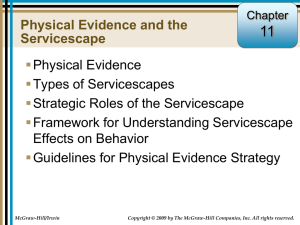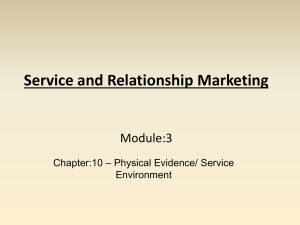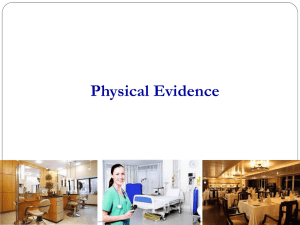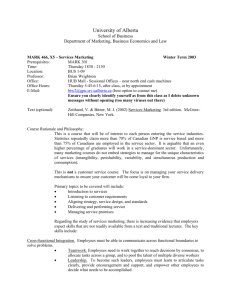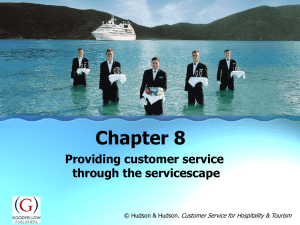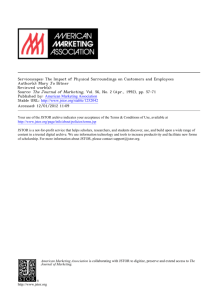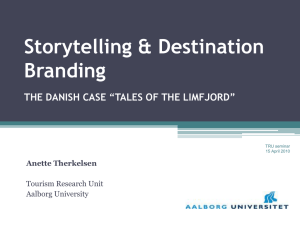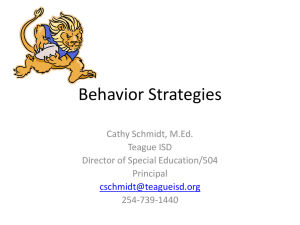Chapter 10
advertisement
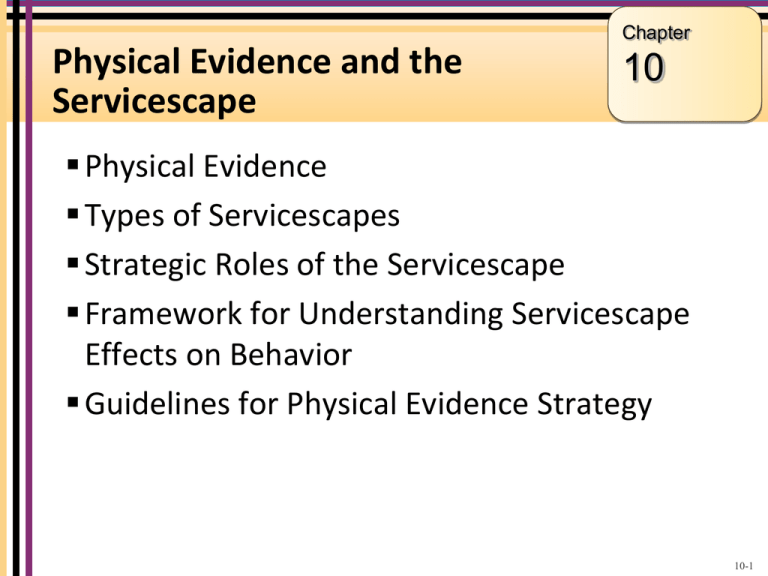
Chapter Physical Evidence and the Servicescape 10 Physical Evidence Types of Servicescapes Strategic Roles of the Servicescape Framework for Understanding Servicescape Effects on Behavior Guidelines for Physical Evidence Strategy 10-1 Objectives for Chapter 10: Physical Evidence and the Servicescape Explain the impact of physical evidence, particularly the servicescape, on customer perceptions and experiences. Illustrate differences in types of servicescapes, the roles played by the servicescape, and the implications for strategy. Explain why the servicescape affects customer and employee behavior, using a framework based in marketing, organizational behavior, and environmental psychology. Present elements of an effective physical evidence strategy. 10-2 Physical Evidence “The environment in which the service is delivered and where the firm and the customer interact, and any tangible commodities that facilitate performance or communication of the service.” Physical facility = Servicescape 10-3 Elements of Physical Evidence 10-4 Examples of Physical Evidence from the Customer’s Point of View 10-5 Examples of Physical Evidence from the Customer’s Point of View How Does Physical Evidence Affect the Customer Experience? Flow of the experience Meaning customers attached to it Satisfaction Emotional connections to company Clue management: the process of clearly identifying and managing all the various clues that customers use to form their impressions and feelings about the company. 10-7 Typology of Service Organizations Based on Form and Use of the Servicescape Whom the servicescape will affect 10-8 Roles of the Servicescape The servicescape is frequently one of the most important elements used in positioning a service organization. Package: ‘wrap’ the service and convey what is ‘inside’ conveys expectations influences perceptions Facilitator facilitates the flow of the service delivery process provides information (how am I to act?) facilitates the ordering process (how does this work?) facilitates service delivery Eg. International traveler find the a poorly designed airport with few signs, poor ventilation, and few places to sit or eat 10-9 Speedi-Lube Spells Out the Service Offering 10-10 Package Facilitator Roles of the Servicescape (continued) Socializer: Helps to convey expected roles, behaviors, and relationships facilitates interaction between: customers and employees customers and fellow customers Employees and fellow employees Differentiator sets provider apart from competition in the mind of the consumer Socializer: Differentiator Understanding Servicescape Effects on Behavior Stimulus-organism-response theory Stimulus = multidimensional environment Organism = customers and employees Response = behaviors directed at the environment Assumption: Dimensions of the servicescape will affect customers and employees and they will behave and respond in different ways depending on their internal reactions to the servciescape. 10-16 A Framework for Understanding Environment-User Relationships in Service Organizations 10-17 Individual Behaviors in the Servicescape Environmental psychologists suggest that people react to places with two general, and opposite forms of behavior: Approach: all positive behaviors that might be directed to a place Desire to stay, explore, work, affiliate Shopping enjoyment, spending time and money Avoidance: negative behaviors Desire not to stay, etc. 10-18 Social Interactions in the Servicescape All social interaction is affected by the physical container in which it occurs Customer-employee Customer-customer Scripts (particular progression of events) Physical proximity Seating arrangements Size Flexibility 10-19 Holland American Cruise Line Internal Responses to the Servicescape Cognition: environment can affect beliefs about a place and the people and products found in that place Emotion: color, décor, music, scent affect mood Pleasure/displeasure Degree of arousal (amount of stimulation) Physiology: volume, temperature, air quality, lighting can cause physical discomfort and even pain Ergonomics: the understanding of the interactions among humans and other elements of a system, and the profession that applies theoretical principles, data and methods to design in order to optimize human well being and overall system 10-21 Variations in Individual Response Personality differences Arousal seekers vs. arousal avoiders Enjoy high levels of stimulation/prefer lower levels of stimulation Environmental screeners Able to experience a high level of stimuli but not be affected by it Purpose for being in the servicescape Business/pleasure Temporary mood state A person after a day at work/ a person after holiday 10-22 Environmental Dimensions Ambient Conditions: affect the 5 senses, but may be imperceptible or affect us subconsciously ◦ Temperature, lighting, noise, music, scent, color Spatial Layout and Functionality: size, shape, and arrangement of machinery, equipment, and furnishings and the ability of such to facilitate customer and employee goals ◦ Accessibility, aesthetics, seating comfort Signs, Symbols, Artifacts: explicit or implicit communication of meaning; often culturally embedded; important in forming first impressions ◦ Way-finding, labels, rules of behavior, creating aesthetic impression 10-23 Guidelines for Physical Evidence Strategy Recognize the strategic impact of physical evidence. Blueprint the physical evidence of service. Clarify strategic roles of the servicescape. Assess and identify physical evidence opportunities. Update and modernize the evidence. Work cross-functionally 10-24 Homework: Use Global Feature on page 300 as a guideline to give example of a service firm (global brand) that adapts to fit with different cultures Give at least example from two countries with pictures of the firm’s servicescapes and other details.
